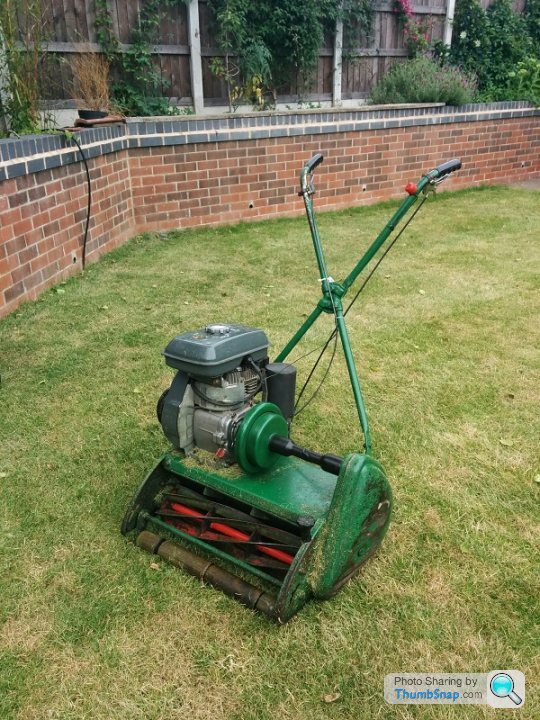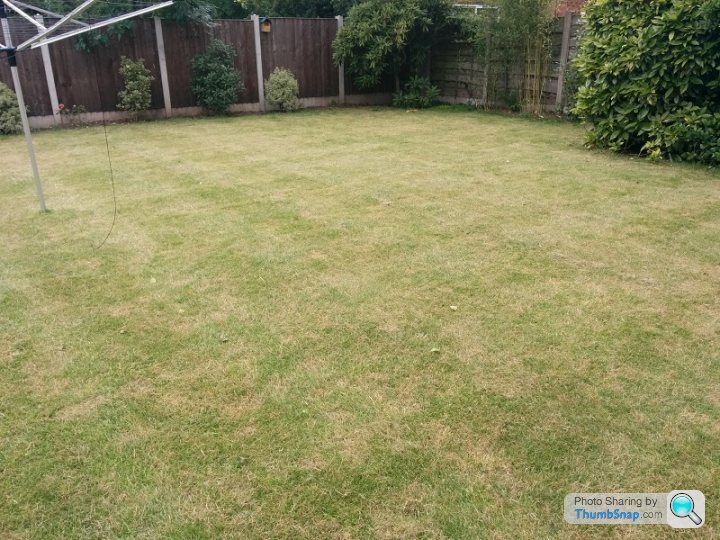2015 Lawn thread
Discussion
I may have made a bit of bad purchase, fed up of scalping my lawn edges with my rotary wheeled mower I decided to get one with a rear roller. Having looked at some Hayter mowers 2nd hand I eventually did a last minute ebay purchase of a 20" Ransomes Marquis cylinder mower.
So having given my lawn a once over I have a number of issue:
So having given my lawn a once over I have a number of issue:
- The clutch release appears a little binary (I had to remove the handle bars to fit in the car and I think it may have lost a part off the cable that holds it in place)so when you let the clutch out it flies across the lawn uncontrollably. Are these mowers possible to control for tight edges?
- Is it simply too large for my lawn? I've previously had an 18" rotary which was fine.
- My lawn is a little uneven in hight so I guess I'll need to level it.
- The Cylinder has a very close cut for my grass. I appear to have scalped it, not down to soil but it looks very short and sorry now.
Ive jsut gone over to a petrol mower, but my garden is quite small.
i bought it of a lad at work, i couldnt help myself its an angine to mess with for £40,
i was quite uspet when i found out it started working first time!
Have a look on ebay for a scarifier, they are quite cheap, wait for the grass to be growing quickly though and dont do it towards the end of the summer,
try and get three sessions in with it,
will post mine later
i bought it of a lad at work, i couldnt help myself its an angine to mess with for £40,
i was quite uspet when i found out it started working first time!
Have a look on ebay for a scarifier, they are quite cheap, wait for the grass to be growing quickly though and dont do it towards the end of the summer,
try and get three sessions in with it,
will post mine later
WinstonWolf said:
Any ideas why I have these brown patches in my lawn? A few years ago I overdid the 4 in 1, could that have permanently damaged the grass?


It won't have permanently damaged the grass.

Those brown patches in the closer photo don't look like the more common diseases to my mind, although I could well be wrong. I don't think it's red thread as there's no tell tale traces of pinky red fibres. Too irregular for animal urine burns as well I think.
Localised drying due to larger stones near the surface? Faster growing patches with too much cut off at once? Localised compaction? Have you fertilised recently - perhaps some scorching from granules.
Some more, slightly closer photos might help. That larger brown patch in the top left of the not so close photo might give more clues if you have any photos of that.
I'd try inserting a screwdriver or similar into the browner areas and the healthier areas and see if there's a difference in how far down it can be pushed and how easily it can be pushed in.
It could well be ants. Deep thatch might also give a similar feeling, or the remnants of organic matter that's decomposed leaving a pocket.
I wonder if your best option then is to take some cores out of the lawn in the trouble areas and it might give some answers. A big kitchen knife works wonders for taking clean core samples as a substitute for the proper tool. Not so good for domestic harmony if you get caught digging up the garden with it, mind
I wonder if your best option then is to take some cores out of the lawn in the trouble areas and it might give some answers. A big kitchen knife works wonders for taking clean core samples as a substitute for the proper tool. Not so good for domestic harmony if you get caught digging up the garden with it, mind

wseed said:
So having given my lawn a once over I have a number of issue:
A Ransomes Marquis is a very good mower. It'd be worth getting it serviced and having the clutch looked at, cylinder and bottom blade ground, bearings checked and have it set up properly. Not knowing how much abuse it's had it's worth spending a bit on it initially to get the best from it. Cylinder mowers really are precision things and a worn and abused one can cause more problems than they solve.- The clutch release appears a little binary (I had to remove the handle bars to fit in the car and I think it may have lost a part off the cable that holds it in place)so when you let the clutch out it flies across the lawn uncontrollably. Are these mowers possible to control for tight edges?
- Is it simply too large for my lawn? I've previously had an 18" rotary which was fine.
- My lawn is a little uneven in hight so I guess I'll need to level it.
- The Cylinder has a very close cut for my grass. I appear to have scalped it, not down to soil but it looks very short and sorry now.
A Marquis will show up deficiencies in your lawn such as bumps and hollows, but it's nearly August so the perfect time to sort out problems like that. It will have a limit on how high it can cut, so if you've gone a bit short as a result don't worry, the grass will recover although you may need to water it if the ground is quite dry.
A 20" cylinder mower, whilst it's noticeably wider than many and is starting to get too big for some lawns, should be ok unless you have a very small lawn or tight awkward areas around the edge of it. If that is the case then sometimes it's worth reshaping borders to increase the radius of corners. Sometimes a 1.5 or 2x width perimeter cut can help. A quality cylinder mower can be quite (very) heavy, making it a harder to manoeuvre in tight areas than a rotary mower. For those really awkward spots that you can't do anything to ease, then I just skip with the mower and get the shears out afterwards. Even my little 12" Ajax has places that it can't get to properly.
Imho it's worth having some sort of rotary mower / flymo as backup for a mower like that. It's useful if the grass gets a bit long (holidays, wet spells, etc) to get it back under control rather than taking off too much at once. It's also useful for cleaning up the lawn after scarifying/hollow tining/leaf fall. If not a rotary then at least a cylinder mower capable of high cuts, even a manual push mower like the Husqvarna 64 which takes up minimal shed space.
my back lawn is something of a work in progress having been battered by rotting leaves last autumn, long story but it was so long and wet at the time I chose to leave the leaves, bad idea, but we learn
its recovered quite a bit since spring however I'm concious it needs some TLC
I've stearted at one end only for the moment with regular watering and feeding and its starting to respond apart from a couple of troublesome brown patches. Those are a discussion for another day
However the untreated end which I left for comparison (it still gets a regular mow twice a week) has in the space of 24 hours grown a large number of mushroom/toadstool colonies
I have no idea why but it seems to be, being taken over.
Any suggestions as to cause or cure?
its recovered quite a bit since spring however I'm concious it needs some TLC
I've stearted at one end only for the moment with regular watering and feeding and its starting to respond apart from a couple of troublesome brown patches. Those are a discussion for another day
However the untreated end which I left for comparison (it still gets a regular mow twice a week) has in the space of 24 hours grown a large number of mushroom/toadstool colonies
I have no idea why but it seems to be, being taken over.
Any suggestions as to cause or cure?
markiii said:
Any suggestions as to cause or cure?
By the sounds of it it's most likely related to the decomposing leaf matter. Most 'shrooms in the lawn aren't a problem, just brush them off before cutting to avoid squashing them under the mower wheels or rollers. There's all sorts of fungi active in the soil, and your grass is dependent on many for nutrients and healthy growth. The one to watch out for is Marasmius oreades or fairy rings, which can cause problems for the grass. The usual course of action with that is to manage the problem as removal requires digging, lots and lots of digging.
wseed said:
I'm going to get a sprinkler tomorrow to keep it watered and I'll make a start on adding a little soil to the low spots.
When watering, deeply and infrequently is much better than little and often unless you're try to germinate new seeds. Wait until the grass is starting to lose its springiness before watering, and a couple of cups placed in the path of the sprinkler will help measure how much water you're adding.Watering little and often encourages shallow root growth making the grass less drought resistant, and it provides ideal conditions for weed grasses such as poa annua which tend to have naturally shallow roots, establishing themselves through rapid seed reproduction and so having little need for a deep root system.
Also finer grasses such as fescues don't like having their roots sat in water for too long, so giving the soil chance to dry out in between helps favour them.
jagnet said:
It could well be ants. Deep thatch might also give a similar feeling, or the remnants of organic matter that's decomposed leaving a pocket.
I wonder if your best option then is to take some cores out of the lawn in the trouble areas and it might give some answers. A big kitchen knife works wonders for taking clean core samples as a substitute for the proper tool. Not so good for domestic harmony if you get caught digging up the garden with it, mind
It *could* be deep thatch, I've been out and given it a rake this morning, it's quite damp and mulchy in the affected areas.I wonder if your best option then is to take some cores out of the lawn in the trouble areas and it might give some answers. A big kitchen knife works wonders for taking clean core samples as a substitute for the proper tool. Not so good for domestic harmony if you get caught digging up the garden with it, mind

Before I take any cores out I have a plan...
Mow every three days, rake deeply before each cut, stop watering (unless it's a drought).
The lawn is at least ten years old, I guess it's due a scarify and over seed at the back end of the year...
WinstonWolf said:
It *could* be deep thatch, I've been out and given it a rake this morning, it's quite damp and mulchy in the affected areas.
Before I take any cores out I have a plan...
Mow every three days, rake deeply before each cut, stop watering (unless it's a drought).
The lawn is at least ten years old, I guess it's due a scarify and over seed at the back end of the year...
If there is heavy thatch under there then you may find that hard raking leaves you with bare patches quite quickly, but that's not really a problem if you're going to be doing end of season renovations soon, although it can leave openings for weeds and weed grasses. You could easily leave it as is for now, for the sake of another month.Before I take any cores out I have a plan...
Mow every three days, rake deeply before each cut, stop watering (unless it's a drought).
The lawn is at least ten years old, I guess it's due a scarify and over seed at the back end of the year...
By the sounds of it your lawn will benefit enormously from a proper going over in the autumn if it hasn't been done in many years, and by the end of it you'll be staring at something that barely resembles a lawn, but it'll be worth it.
A good, deep scarification (several passes, at gradually lower depths) followed by hollow tining will pull out a lot of thatch and debris. Hire in a proper scarifier and hollow corer - minimal cost for a day really and they have the power to do a proper job on the lawn. Domestic electric scarifiers are ok for pulling out moss but they're not going to be able to penetrate the surface.
If you do have a really deep thatch problem then you may not be able to scarify it all out in one go - if you try to then you'll have no grass left, but get out what you can.
Top dressing is optional for most lawns, but it really does help and if you want a more ornamental lawn then I think it's fairly essential to help level out low spots and to give the grass the best chance when being cut low all year. Mixing some good compost in with the top dressing helps all the soil microbes, bacteria and fungi which in turn help break down thatch and strengthen the grass against disease. Deeper depressions may have to be tackled by peeling back the turf and filling in.
Taking a core or two before you start will help in understanding what's going on under the turf, and what your soil composition is like so that you can better match your top dressing to that soil. A sandy dressing on a heavy soil, or vice versa, just isn't going to mix well and you'll end up creating a soil horizon that grass roots will struggle to bridge.
Finally add a starter fertiliser and overseed at new lawn rates. If the lawn is small enough that buying enough horticultural fleece isn't going to break the bank then it's worth using it to help the seed germinate. A light covering of straw is a cheaper alternative.
I love autumn for lawn care fun

There's no doubt that my lawn is suffering from the lack of rain the last few months, despite watering, so I'm looking forward to giving it a good scarification next month. It's still holding up better than most in the area though despite the low HoC, where playing 'spot the green lawn' when out walking last weekend was an exercise in frustration. The only green in most lawns was coming from weeds. I reckon we've had less than 10mm of rain since spring. Even yesterday, driving back from W Sussex where it was tipping it down, by the time it reached here there wasn't even enough to dampen the dust down. Trying to do the borders last weekend, I'd have been better off with a kango hammer than a hoe. On the plus side, it's been the best year for our gooseberries that I've seen, on the downside I'm running out of gooseberry recipes

Edited by jagnet on Thursday 23 July 14:17
wseed said:
The beast responsible, am I right in thinking if I cut regularly enough I can cut without the grassbox?

That's quite an engine on that. My Dennis has a Kubota engine and it definitely doesn't suffer a lack of power despite having to move over 100kg of mower. Lovely engines 

hardcastlephil said:
That definitely warrants a bigger mower:http://www.ebay.co.uk/itm/Dennis-lawnmower-36-inch...

Gassing Station | Homes, Gardens and DIY | Top of Page | What's New | My Stuff



 king horrendous for a lawn!
king horrendous for a lawn! 
